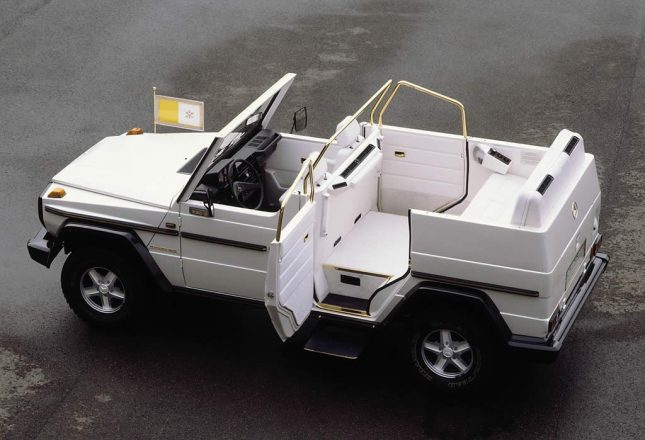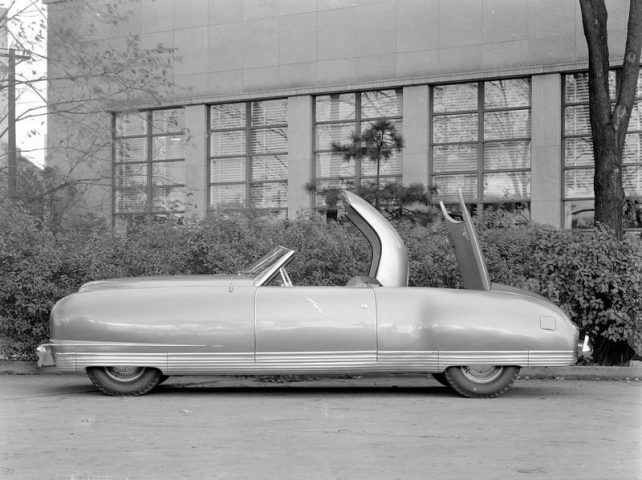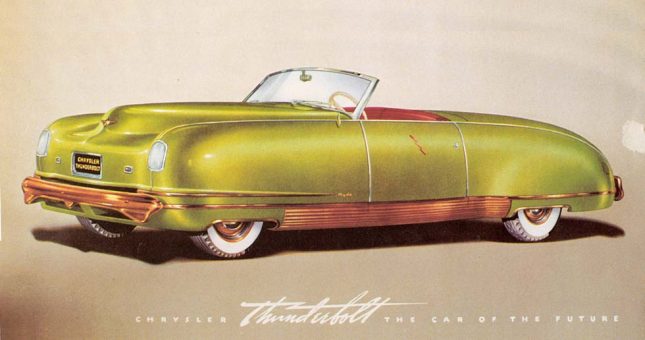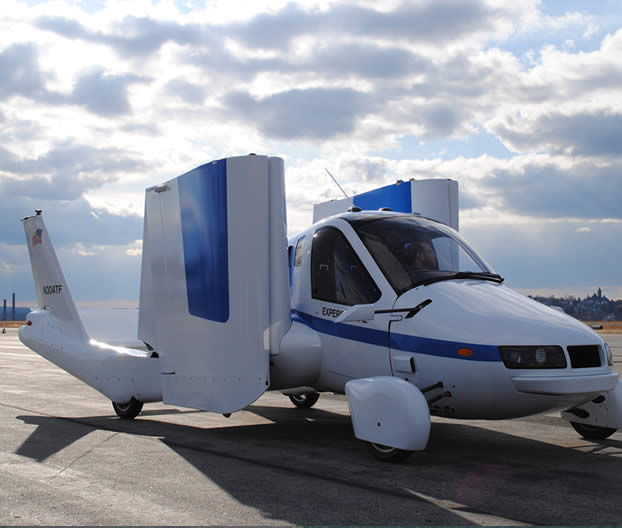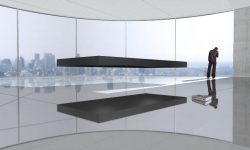Updated April 2, 2022. Car designers and manufacturers have not had an easy job throughout history. Indeed, many of the cars were considered true successes but there were also creations that were categorized as unusual. Weird or not, these bizarre cars helped to develop this domain by introducing something unique each time, be it a single line of design, a feature, a technology, or an engine.
So without further ado, let’s see the weirdest and most bizarre cars ever made.
1986 Lamborghini LM002


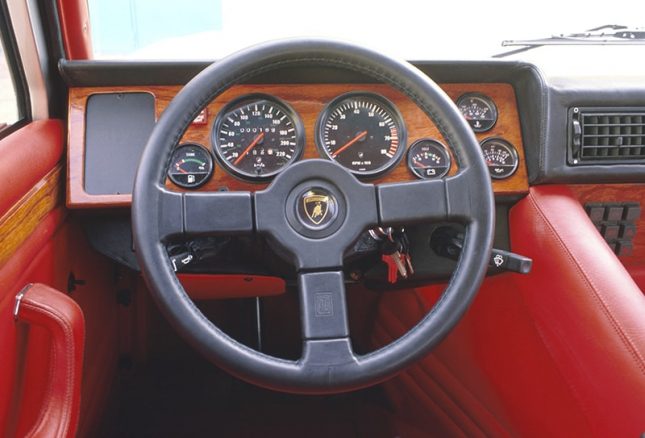

The 1986 Lamborghini LM002 was manufactured between 1986 and 1993 for military purposes, being part of the so-called “Lamborghini Militaria” series. The “Rambo Lambo” had four seats and an interior made of wood and leather while under the hood was a 444hp engine with six Weber carburetors. Unfortunately, the car was not used for that purpose, but it remained known as one of the coolest off-road vehicles made by Lamborghini due to the fact that it was hand-built.
L’Oeuf Electrique
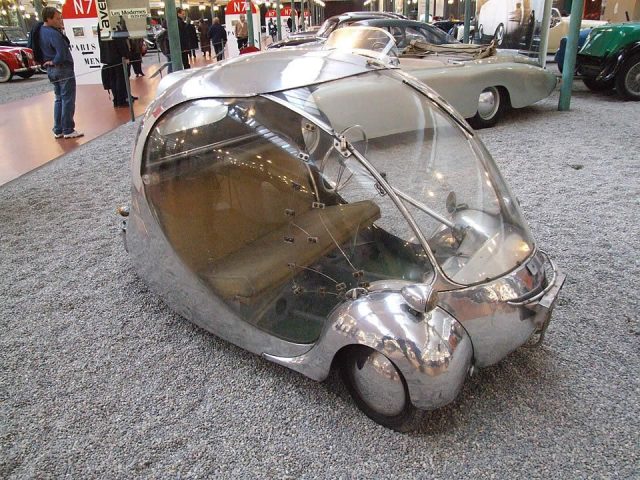
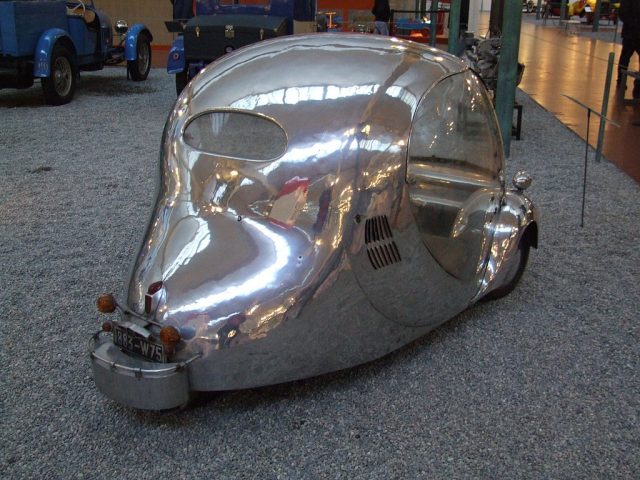
The L’Oeuf (the egg) was an electric car created long before Tesla, specifically in 1942. Built by a famous French industrial designer called Paul Arzens in a time when gasoline was not available to the public, the L’Oeuf Electrique was a two-seat car that boasted a very oddly egg-shaped design. The car’s bodywork weighed 132 lb (60 kg) due to the fact that it was made only of an aluminum shell with Plexiglas and when adding the electric rear and batteries, the weight reached a total of 772 lb (350 kg). Last but not least, this tiny, odd car was built entirely by hand and could reach a top speed of 37 mph with two people on board.
Paul Arzens is also known for designing another weird car called La Baleine (the whale) – 1938, 3500 ccm, 160 km/h.

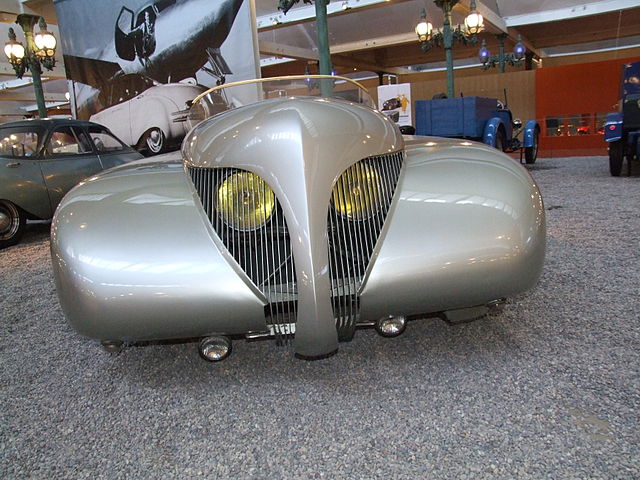
General Motors Firebird I, II, III, IV
The Firebird I, II, III, and IV were not built for production but mainly for the Motorama auto shows from 1953, 1956, and 1959 with the main purpose of showcasing the incredible technology that General Motors was capable of achieving. All these GM prototypes were designed by Harley Earl, who was General Motors‘ chief design officer and later the company’s vice president. Harley managed to find inspiration in the design of the aircraft, the proof being the logo of the General Motors Air Transport Section that all four prototypes display. If you are a car enthusiast you should know that all four prototypes can be seen in the Henry Ford Museum in Dearborn, Michigan. Now, let’s take one prototype one at a time:
Firebird I
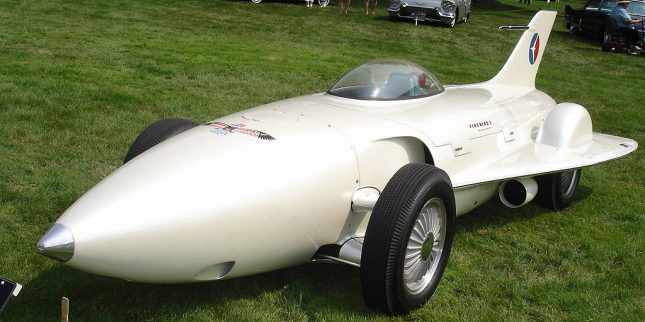
Initially called XP-21, the Firebird I was not such a practical car having only one seat, but it amazed the auto show with its Whirlfire Turbo Power gas turbine. At that time, the Firebird I was the first gas turbine-powered car in the US with bodywork made entirely from fiberglass weighing 2,500 lb (1,134 kg).
Firebird II
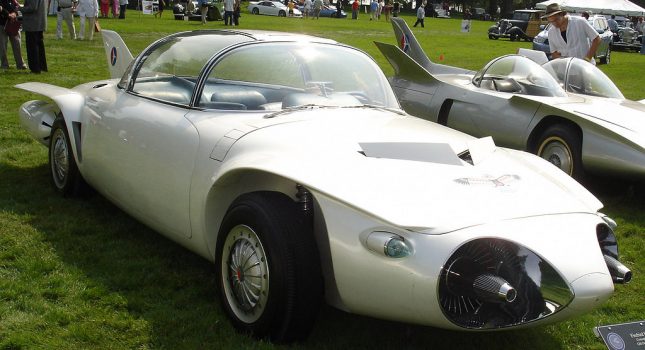
Unlike the first prototype that was totally impractical, the Firebird II or XP-45 was a family car with four seats and bodywork made exclusively from titanium. Boasting a 200hp engine output, this car was designed with a regenerative system to combat the heat problem. Through this car, General Motors introduced the first disc brakes on all four wheels, an independent suspension, as well as a non-operational guidance system that emitted signals and guided the car in order to avoid accidents.
Firebird III
The Firebird III or XP-73 boasted two seats, a fiberglass body, and a canoe-shape with seven wings. Having a 225hp Whirlfire GT-305 gas turbine engine, this car’s outstanding features were the cruise control, anti-lock brakes, air conditioning, air drag brakes, an ultrasonic key that opened the doors via signals, and a “no-hold” steering system.
Firebird IV

The Firebird IV was created for a different future where the cars run automatically. The non-functional car was displayed in 1964 at the General Motors Futurama auto show and was destroyed in 1980.
Sunswift V (eVe)

Designed and built completely in only 18 months, Sunswift eVe is one of the sixth creations of the UNSW Solar Racing team of the University of New South Wales in Sidney, Australia. The main reason for this incredible odd car creation was the participation in the World Solar Challenge. Boasting a modern design, a carbon fiber chassis, and a top speed of 80 mph (128 km), the Sunswift eVe had an autonomy of 310 mi (500 km) and 500 mi (800 km) if powered by its own solar cells. The car weighed 930 lb (430 kg) and took approximately 10 hours to fully charge it with a standard household. The entire development of the Sunswift eVe cost $500,000.
Peel P50
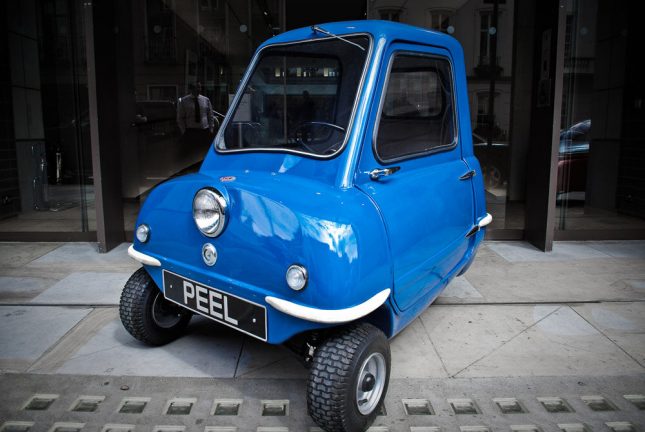
Next on our list is not a car but a three-wheeled microcar called Peel P50. Manufactured between 1962 and 1965 by the Peel Engineering Company, this tiny car was the only one produced in the Isle of Man and listed in the 2010 Guinness World Records as the smallest production car ever made. Weighing only 130 lb (59 kg), the car has only one seat and was advertised as being a perfect city car for “only one person and a shopping bag”. With a retail price of £199 (about $8,500), the microcar had a three-speed manual transmission, a top speed of 37 mph (60 km), and no reverse gear.
Stout Scarab

Designed by a motorcar engineer named William Bushnell Stout and manufactured by Stout Engineering Laboratories, the Stout Scarab was the first production minivan in history. The first functional prototype was completed in 1932, while the second, which had undergone slight changes from the first, was finished in 1935. Incredible lightweight due to its aluminum spaceframe unit construction body, this car had some stunning features such as a Ford V8 engine that developed up to 95 hp, an independent suspension, foldable car tables, configurable seating, and lots of doors for each passenger.
1980 Mercedes-Benz 230 G “Popemobile”

In addition to the peculiar shape of the vehicle, the “Popemobile” had a multitude of other incredible features. The 1980 Mercedes-Benz 230 G was named “Popemobile” after Pope Paul IV used it in his public appearances. A transparent structure was placed on the car to give Pope both visibility to greet the hundred thousand people present at the event, as well as increased protection. Characteristics include a four-cylinder petrol engine that developed 102 hp, an automatic air conditioning unit, and an automatic transmission.
Rinspeed sQuba
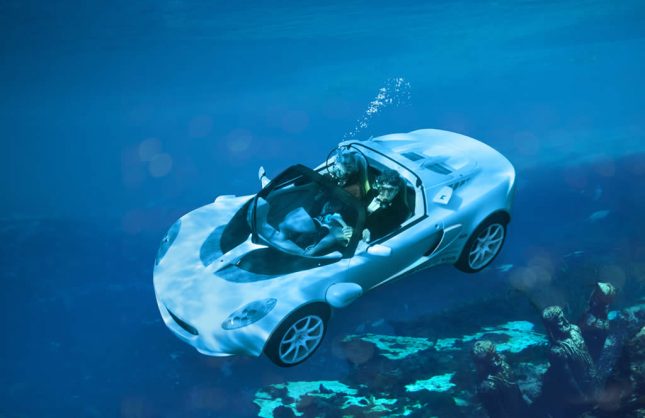
The next car on the list is called Rinspeed sQuba. It was presented for the first time to the public in 2008 and was inspired by the 1977 James Bond movie “The Spy Who Loved Me”. sQuba is an electric car powered by three electric motors that can be driven both on land and at sea. With the chassis borrowed from Lotus Elise, this car has a top speed of 75 mph (120 km/h) and 3.7 mph (6 km/h) on the water.
Chrysler Thunderbolt
The Chrysler Thunderbolt was truly a revolutionary car of the ’40s. The car was first released at the 1940 New York Motor Show and amazed everyone with plenty of electrical features such as electro-hydraulic doors, electric windows, and pop-up headlights. The car’s engine was capable of producing up to 143 horsepower while the roof was electrically retractable. Unfortunately, only 5 cars have been produced, but the good news is that 4 of them still exist in modern times.
Cadillac Cyclone

The Cadillac Cyclone was “a car of the future” due to its futuristic design and incorporated technologies. With this car, Cadillac introduced proximity sensors or the “radar-operated collision avoidance system” for the first time, which was a real innovation in the ’60s. These sensors were represented by two black cones located in front of the car and alerted the driver in case an object or a vehicle was too close. Other features of this Cadillac Cyclone included a 104″ wheelbase chassis, an independent suspension, and a rear-mounted automatic transaxle.
Norman Timbs Special
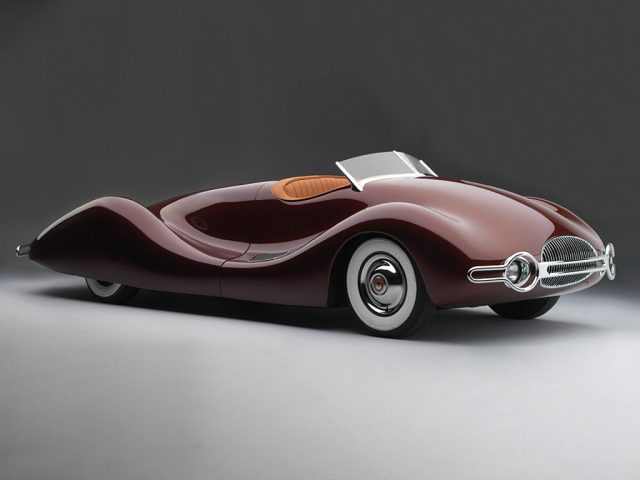
Working as an automotive engineer on Indy 500 racecars, Norman Timbs was so determined to manufacture his own car that he worked for three years and invested approximately $10,000 to complete his wonderful prototype. Eventually, this would become the Norman Timbs Special. The car stood out through both its elegant design and sleek shapes, as well as its 1948 Buick Straight 8 engine with dual carburetors, which was capable of producing up to 120 mph. The car weighed 2,200 lbs (1,000 kg) and had a 117″ wheelbase, as well as an aluminum body and an independent rear suspension designed by Timbs itself using Packard and Ford components.
1980 Subaru BRAT

Manufactured by the Japanese in 1977 for North America specific demands, the Subaru BRAT (Bi-drive Recreational All-Terrain Transporter) was sold between 1978 till 1994 and had a specific name for each of the marketplaces in which it was available. It was known as Subaru 284 in the United Kingdom, Subaru Brumby in Australia, and Subaru MV, Targa, and Pickup for the other markets. The car was fabricated for export only and was never sold in Japan due to the small demand for coupé cars, with the Japanese preferring station wagons. The models produced until the 1980s were equipped with a 1.6-liter EA-71 engine, while those after 1981 had a 1.8-liter EA-81 engine. Other features include manual transmission, an optional T-top split roof, and a spring-loaded hidden door.
1950 BMW Isetta 300

This tiny, good-looking car broke all the records of its time by becoming the world’s first mass-production car as well as the top-selling car in the world. With a capacity of only two persons and fuel consumption of 3l/100km, this car was originally created by an Italian company called Iso SpA that allowed its sale under various licenses such as BMW Isetta in Germany and Velam Isetta in France. The 1980 BMW Isetta 300 is the predecessor of the BMW 250 and appeared due to the change of cars regulations in Germany. The old engine of the 250 Isetta was replaced with a 300cc one that offered a power output that rose to 10 kW (13 hp) at 5200 rpm, and the torque rose to 18.4 N⋅m (13.6 ft⋅lbf) at 4500 rpm. The rest of the Italian elements that defined Isetta have remained largely unchanged.
Ferrari 512S Modulo

Looking like a UFO concept car, this Ferrari 512S Modulo was a sports car equipped with a Ferrari V12 engine which developed 55hp (410 kW) and ranged from 0 to 60 mph (97 km/h) in 3.0 seconds. The 512S Modulo was first released at the 1970 Geneva Motor Show where it was displayed in impeccable black. The main features of this car were the wheels that are partially covered and the 23 holes in the engine cover. It is worth mentioning that this car won 22 awards for its futuristic design.
1948 Tasco
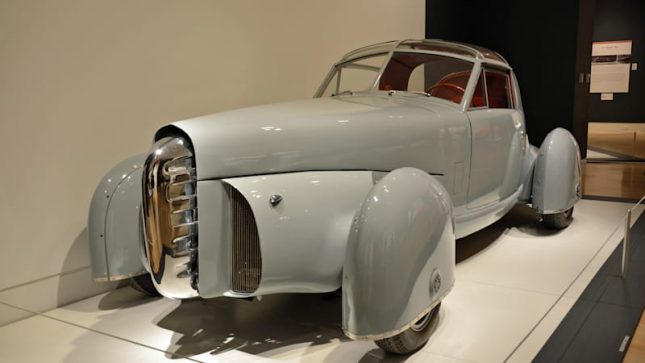
Another spectacular car with a very weird design is the 1948 Tasco. The vehicle was designed by Buehrig and even though it never went into the production phase, it had some special technologies. Equipped with a Ford flathead V-8 engine able to develop up to 150hp, the 1948 Tasco (an acronym for The American Sports Car Company) was a two-seater car with a long hood and short deck. The most exceptional feature of the car was the pair of lift-out plexiglass roof panels, which was the invention of the Buehrig himself. He later named the invention “roof with movable parts” for which he completed a patent, which he received in 1951.
1955 Chrysler (Ghia) Streamline X ‘Gilda’
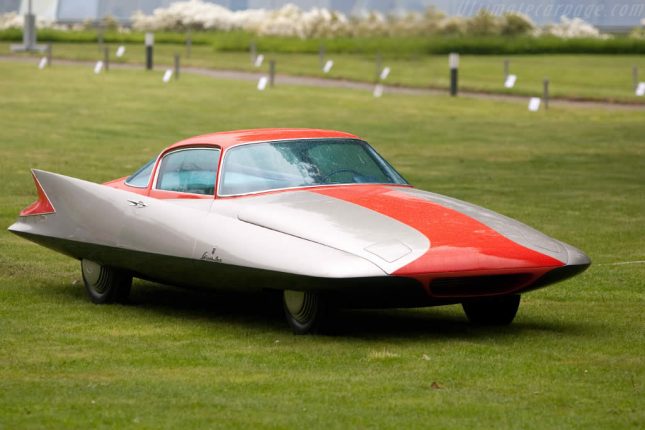
Launched in 1955 during the Salone di Torino, the 1955 Ghia Streamline X ‘Gilda’ was named “one of the most significant show cars” by the American car designer Strother MacMinn. With a name inspired by the 1946 film Gilda, the car should have had a top speed of 140 mph (225 kph), but it was never tested because it never had an engine assembled.
Reliant Robin
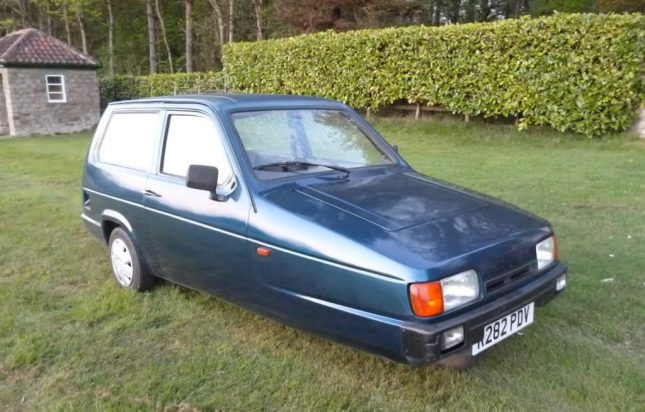
The Reliant Robin, with its quirky look, has been produced by Reliant Motor and designed by Ogle Design Ltd under the name TW8. The four-seater car was equipped with an 850 cc, four-cylinder engine capable of developing a top speed of 85 mph. The car had incredible success in Great Britain, being one of the best-selling cars in the country. This success was largely due to its 992 lb (450 kg) weight, which allowed its registration and taxation at motorcycle rates.
Nissan S-Cargo

Ranked in the list of the most bizarre cars ever built, the Nissan S-Cargo incorporated many of the interior and exterior design features from Citroën 2CV Fourgonnette. Manufactured by Nissan and first presented at the 1989 Tokyo Motor Show, the S-Cargo was equipped with a 1.5 L E15S 4-cylinder petrol/gasoline engine, a 3-speed automatic transmission, and air conditioning. The car was sold exclusively in Japan and only in Nissan Cherry Stores. In all, only 8,000 copies were sold between 1989 and 1991.
Messerschmitt KR200
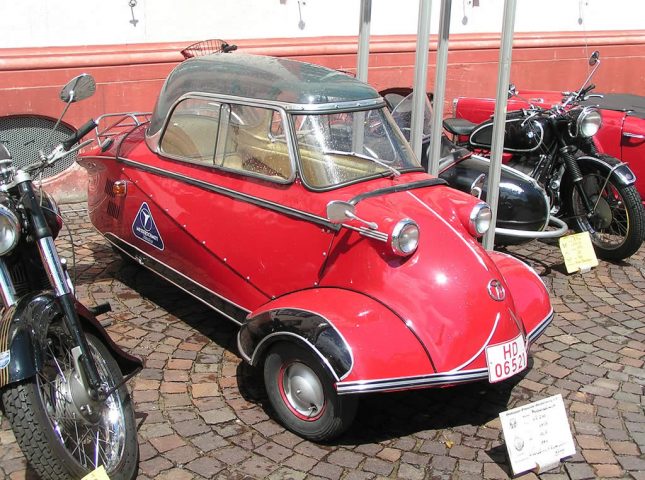
During the time when the aircraft engineer Fritz Fend was not allowed to build aircraft, he decided to manufacture his own bubble car. This is how the first Lend’s car and ancestor of Messerschmitt KR200 appeared. The KR200 kept the same body frame as the KR175 but underwent design and technical changes such as a new rear suspension, hydraulic shock absorbers on all three wheels, and a full set of pedals with clutch, brake, and accelerator. A total of 30,286 units were built between 1955 and 1964 and were mostly sold in Germany.
Amphicar Model 770

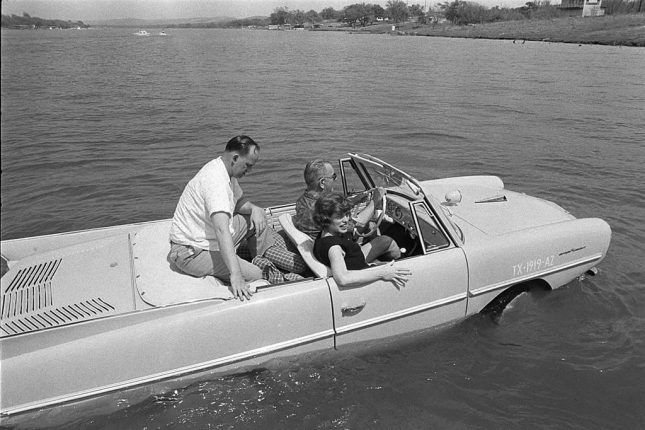
Here we go again. Another car that can be driven on both water and land. Manufactured by the Quandt Group in West Germany, the Amphicar Model 770 was the creation of the Hans Trippel. This amphibious vehicle was built of mild steel and powered by a Triumph four-cylinder engine of 1147 cc with a total power output of 43 hp (32 kW). Furthermore, it incorporated a pair of twin propellers that developed a speed of 7 knots in the water while externally, the narrow body, the low wheels, and the foldable top were among the more obvious features. The car was built in less than 3,900 units and one of them was owned by US President Lyndon B. Johnson, which he drove on his property lake near Johnson City, Texas.
Bond Bug

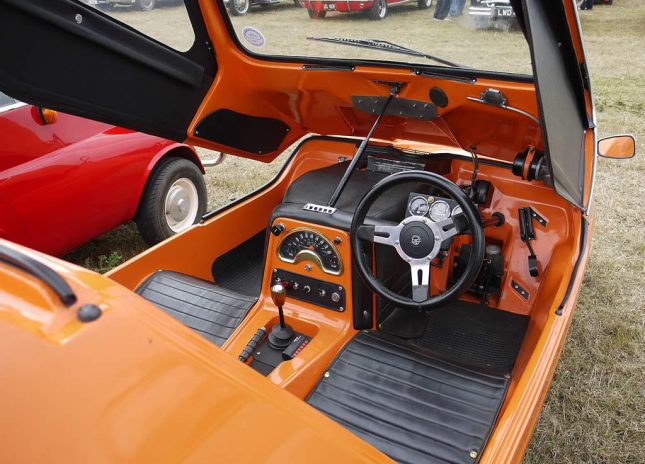
With a funny name and a carrot-like color, the Bond Bug was a two-seat, three-wheeled car that was introduced in June 1970 for the first time. Equipped with a 4-speed manual transmission and a 700cc engine, the car was designed by Tom Karen, especially for the younger generation. As for features, it included ergonomic seats, side screens instead of doors, an ashtray, and a spare wheel.
Davis Divan
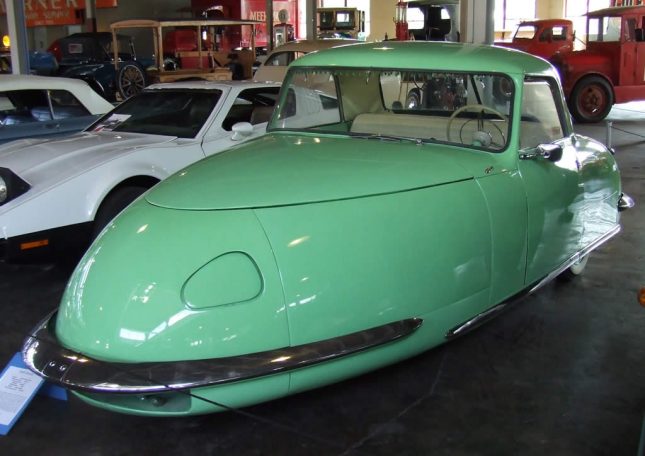
Next, we have another three-wheeled car, but this time a convertible one. The David Divan was a car with a complicated history, but despite this fact, 12 of the 13 cars ever manufactured survived. Designed by Frank Kurtis and Gary Davis, the David Divan vehicle had a small production in Van Nuys, Los Angeles, California, which was closed after two years due to the fact that the company failed to deliver the ordered cars. It is worth mentioning that this three-wheeled, convertible car came with two types of engine called Continental I4 with 64 hp (47 kW) and Hercules 4 with 47 hp (34 kW), as well as disc brakes and hidden headlights.
1970 Lancia (Bertone) Stratos HF Zero

If you ask yourself how low a car can be built, then the 1970 Lancia Bertone Stratos HF Zero could be the answer to your question. Responsible for the abstract design and low ground distance of 3 feet was the head designer Marcello Gandini at Bertone. The car was unveiled at the 1970 Turin Motor Show, the same city of Italy where the car production took place. As for the interior of the car, it featured black, leather seats and a steering wheel with a spherical center.
2001 BMW GINA Light Visionary Model
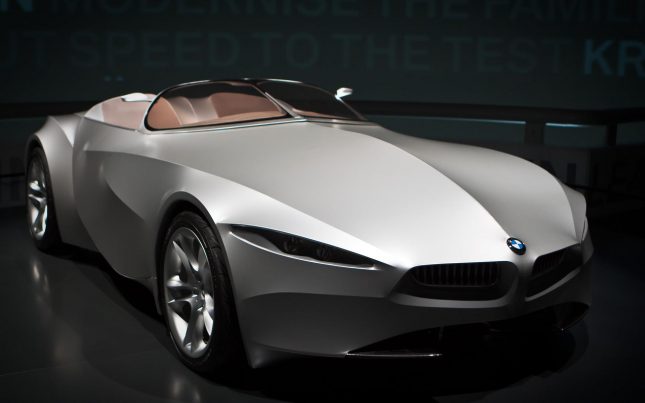
Moving on to a BMW production car, we’ll cover the GINA Light Visionary Model, whose name stands for “Geometry and functions In ‘N’ Adaptations”. The design and manufacturing of this car was not an easy task for the head designer Chris Bangle and his team due to its futuristic shapes and materials used in the manufacturing process. In fact, BMW manufacturer introduced through this car its famous polyurethane-coated fabric called Spandex or, as BMW called it, “elastic, water-resistant, translucent artificial fabric”. What is also important to highlight is that the manufacturing process of the 2001 BMW GINA Light Visionary Model started in 2001 and was completed in 2008.
1935 Bugatti Type 57S Competition Coupe Aerolithe

One of the most impressive vehicles of the ’30s was the 1935 Bugatti Type 57S Competition Coupe Aerolithe. Created by Jean Bugatti, the son of the founder Ettore, the car was finished in 1935 and unveiled in the same year during Paris Motor Show. The car’s body panels were made of Elektron composite, which was very lightweight and durable, but at the same time, it was an extremely flammable material in extreme temperatures. Unfortunately, the car did not have many orders and only four were built in total, of which three are survivors.
1932 Ford Model 18 Edsel Ford Speedster
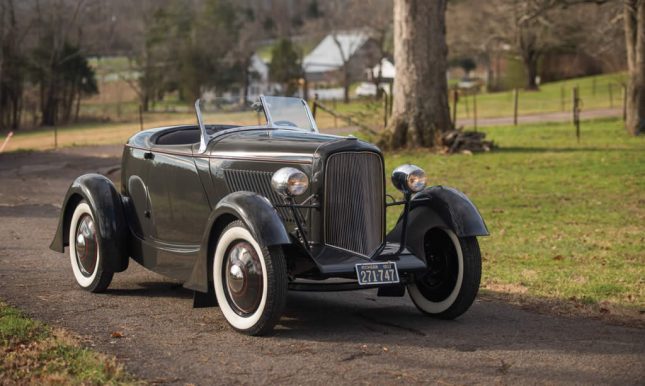
The 1932 Ford Model 18 Edsel Speedster was developed by Edsel Bryant Ford, the son of Henry Ford, the founder of the Ford Motor Company. Edsel found his inspiration during a European trip, and with the help of Gregorie, he managed to translate his ideas into actual sketches. The car boasted a low and sleek design, a Ford flathead V8 engine, as well as body panels made from sheet aluminum at Ford’s Aircraft Division.
1934 Voisin C-25 Aerodyne
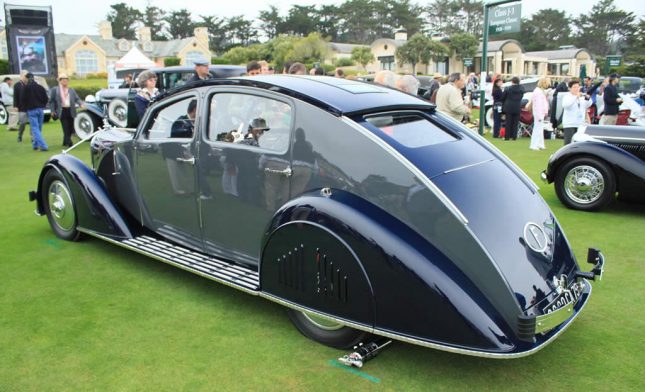
Made by a French company, the 1934 Voisin C-25 Aerodyne was the vision of the Gabriele Voisin and a real luxury vehicle with unusual-modernist lines for its era. The four-seat car was presented at the Paris Motor Show, where it amazed everyone with its modern design inspired by the world of aeronautics. Some of the innovations of the Voisin C-25 Aerodyne vehicle were: the adjustable shock absorbers, retractable roof, a two-speed gearbox with electromechanical overdrive, Jaeger gauges, and Lalique ashtrays added in the car’s doors.
1951 GM Le Sabre

Like many other cars from the 50′, the 1951 GM Le Sabre design was inspired by the aircraft’s world. It was created by the Head of the Art Department at General Motos called Harley Earl, who was also recognized for its other Y-Job concept. In addition to the stylish design and the 3.5-liter V8 engine powered by either gasoline or methanol, the Le Sabre vehicle was also equipped with the Buick Dynaflow automatic transmission that did not require the changes of gears when driving. The most attractive features and technologies of this vehicle were: the heated seats, electric headlights, front bumper dagmars, a 12-volt electrical system, and a body made from a special material that included aluminum, magnesium, and fiberglass.
1956 Buick Centurion

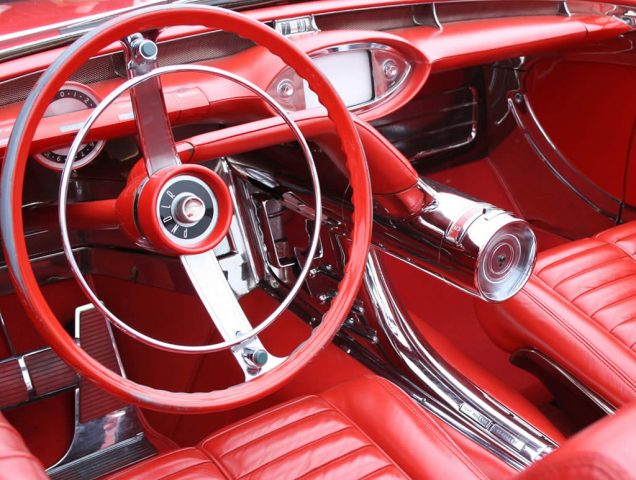
Unveiled at the 1956 General Motors Motorama Show, the 1956 Buick Centurion was a car that totally revolutionized the American car seats of that time by including sliding front seats, as well as headrests. In this way, the car was able to offer four seats instead of the usual two. But that is not all. The 1956 Buick Centurion was one of the first cars to also introduce the feature of the rearview camera that projected the image from the rear of the car directly on a screen embedded in the dashboard. Lastly, Centurion’s interior was made from fiberglass, while its V8 engine was able to produce 325 horsepower.
Citicar

With more than 4,440 units sold, the Cititcar was one of the best-selling electric cars in history. Part of the success of this car was due to the fuel crisis of 1970, which led people to turn to other alternatives. But its record was later surpassed by none other than Tesla Model S. The car was produced in the ’70s by Sebring’s company founder Robert G. Beaumont, which inspired himself from the golf car named the “Club Car”. The car was available in three models with different engines: the first one had a 2.5 hp (1.9 kW) motor and 36V battery pack, the second one a 3.5 hp (2.6 kW) motor and 48 V battery pack, and the last a 6 hp (4.5 kW) engine.
1967 Fiat Multipla
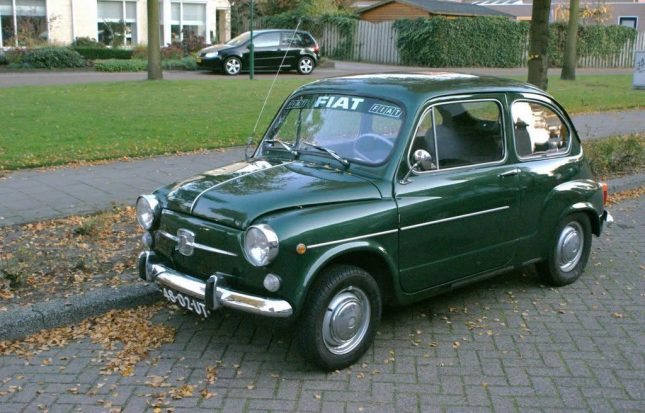
The 1967 Fiat Multipla can boast that it was not just a concept vehicle, but a car with a huge production. With a number of 2,695,197 units sold between 1955 and 1969, the car aimed to be as economical and spacious as possible for urban space. So, the car reached a final price of about €6,700 or US$7300 in today’s days and weighed around 992 lb (450 kg). As features, this water-cooled car included an independent coil-over-shock absorber setup, hydraulic drum brakes on all four wheels, and defrosting systems.
Fiat 600 Multipla
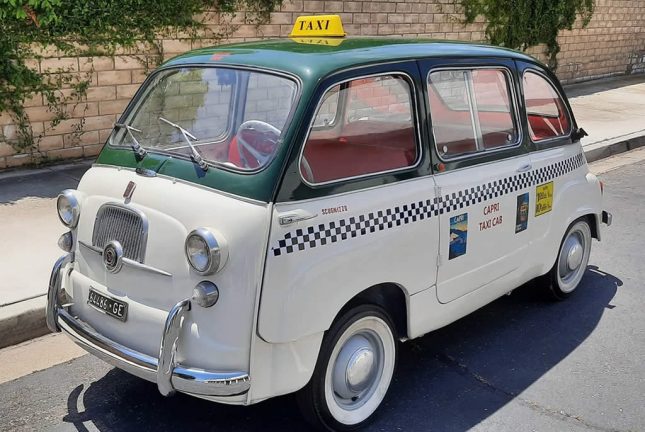
The Fiat 600 Multipla or Fiat Multipla Compact Minivan as it was later called, was a four-door car model with a capacity for six persons. Like all the other Multipla, this was also manufactured in Italy and was equipped with a manual 4-speed gearbox and the type 100.000 663cc overhead-valve inline-four cylinder engine that developed 21.2 hp. Those that ordered one had to choose from three interior versions: the one with 4/5 seats, the 6-seater configuration, or the taxi version that had an extra-luggage shelf and a bench seat.
Maybach Exelero

Being the brainchild of one of the most luxurious car brands in the world, the Maybach Exelero was designed in 2004 and unveiled a year later at the Tempodrom Show in Berlin. With an all-black exterior design, this luxurious sports car was equipped with an experimental model of tires called Fulda Carat Exelero, which was specially designed for speed racing. As for the technical performance, this car hid under the hood a twin-turbo V12 engine that could produce up to 700 PS (690 hp; 515 kW) at 5000 rpm and 752 ft⋅lb (1,020 N⋅m) of torque at 2500 rpm.
World’s Longest Limo ( The American Dream)

Created in 1986 by Jay Ohrberg of Burbank, in California, USA, the American Dream limousine made it in the Guinness Book of World Records as being the longest car in the world. The limousine had a total length of 30.5 m (100 ft) and was manufactured from two different sections that were put together in the middle by a hinge. As features, the world’s longest car included lots of TVs, telephones, a water bed, a jacuzzi, a swimming pool, and a lounge.
Terrafugia Transition
Terrafugia Transition was a futuristic flying car that could easily turn from a road vehicle into an airplane. The aim of the company that developed this concept was to achieve a flight range of 425 nmi (489 mi, 787 km), as well as a flight speed of 93 kn (107 mph, 172 km/h). Terrafugia started working on this unique concept in 2006, and by 2014 they presented the third prototype ever built that also received all the necessary certificates to perform the first flight. In 2021 Terrafugia announced that it would close its operations in the US, so it seems that in the end, this prototype will not have another development stage.
1964 Mini Moke

Originally created with the thought of joining the British Army as a military vehicle, the 1964 Mini Moke served in the end as an urban car. Designed by Sir Alec Issigonis, the car was manufactured in the UK, Australia, and even Portugal, reaching 50,500 units produced. The British Mini Moke had a low-end 848 cc transverse inline-four engine, while the Australian one was equipped first with a 998 cc engine and later with a 1,098 cc. Even though it was not successful in its military career, the Mini Moke was so popular that the Australians also launched a pickup model.
2014 Volkswagen XL1
The story of the 2014 Volkswagen XL1 started in 2002 when it was first presented to the public, but its actual production began in 2013. From the beginning, Volkswagen set out to make this car extremely light and have limited production of only 250 units. Therefore, the XL1 Hybrid offered only two seats and had a weight of only 795 kg (1,1753 lb). Available only in Europe from a price starting at €111,000, the car had an extremely impressive fuel consumption of 1 liter of diesel per 100/km thanks to its 800 cm3 two-cylinder diesel engine and a 20 kW (27 hp) electric motor.
1973 Volkswagen Thing

Known by various names in Germany ( Kurierwagen), the United Kingdom (the Trekker), and the United States (the Thing), the 1973 Volkswagen Thing was a four-seater car that served as a military vehicle during World War II. With a massive success, this car had as features the following: a manual transmission, an engine mounted in the rear, removable doors, a folded-flat windshield, and an interior covered in vinyl.
1962 Invader GT
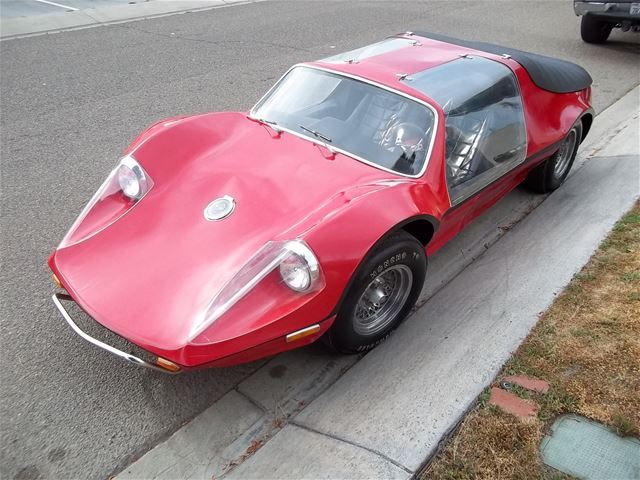
Another car from the ’70s was the 1952 Invader GT. Originally equipped with a Volkswagen engine, this car was very famous due to its bold exterior design that featured Plexi headlights covers and removable doors, as well as its red carpet interior.
1935 Bugatti Type 57S Atalante

The Bugatti Type 57 was, in fact, not just a car, but a whole line of glamorous cars. Even if they were all special, the 1935 Bugatti Type 57S Atalante was the most popular and desired Bugatti. This car became famous again in 2008 when a unit with chassis number 57502 was rediscovered in a garage in the United Kingdom. The car had been built on the original Type 57 chassis and had the following features: a 3,257 cc DOHC inline 8-cylinder engine, a Stromberg carburetor, a four-speed manual gearbox, and an aluminum body.
Aston Martin Lagonda Series 2

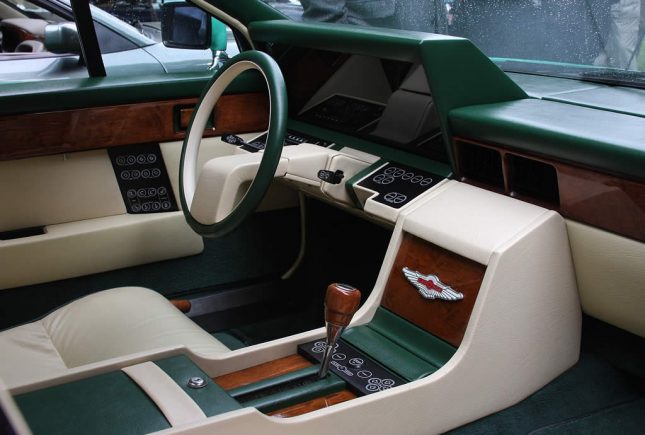
The Aston Martin Lagonda Series 2 was basically a new-better version of the first generation of Lagonda called V8. Produced between 1976 and 1985, this car shared the same 5.3-liter engine that could accelerate from 0-97 km (0-60 mph) in 8.8 seconds as the first series, but the interior and exterior were totally different. The exterior boasted a bold design with pop-up headlights, while the interior had an LCD dashboard with touch buttons.
Karlmann King
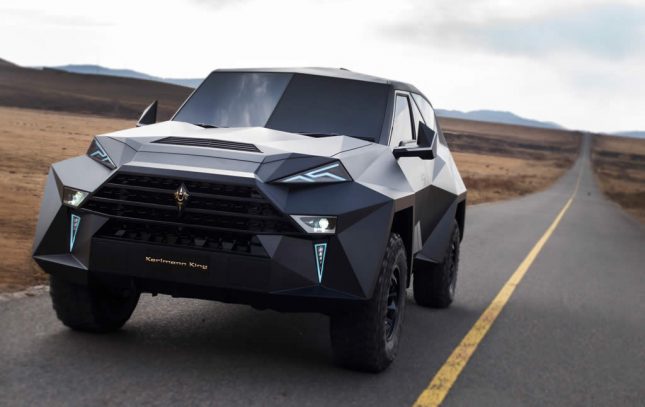
Manufactured in Italy, the Karlmann King is, at first glance, a real beast due to its imposing design and its 6.8-liter V10 engine hidden under the hood capable of producing up to 398 hp. With a weight of 10,580 lb, the car has a maximum speed of 87 mph. The truly remarkable features of this car are the flat-screen, electric tables, the bar, the laptop, the fridge, and Wi-Fi.
2020 Polaris Slingshot
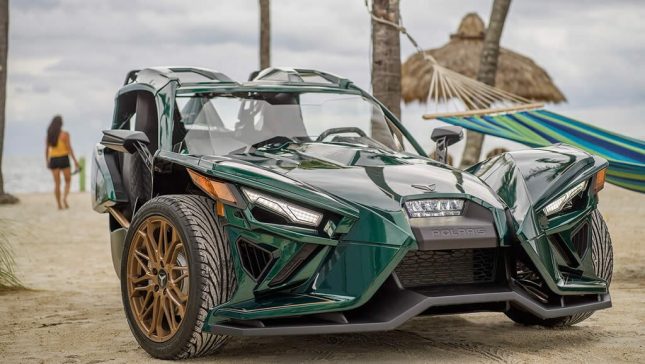
Featuring an outstanding sporty design, the Polaris Slingshot can be found more in the category of a three-wheeled motorcycle than in a car category. Actually, depending on the jurisdiction, the Polaris Slingshot can be registered as a motorcycle or an autocycle. The car was first introduced in 2014 and is available in four different models called Slingshot S, SL, SLR, and R. The main difference between all these models is the tires’ size. The car’s interior is completely waterproof while under the hood, a 2.0-liter inline four-cylinder Polaris ProStar Engine capable of depending 203 hp (151 kW) is hidden. Other features of the Polaris Slingshot are the adjustable steering wheel, the double-wishbone suspension, and the 5-speed automatic transmission.
Vision Mercedes Simplex
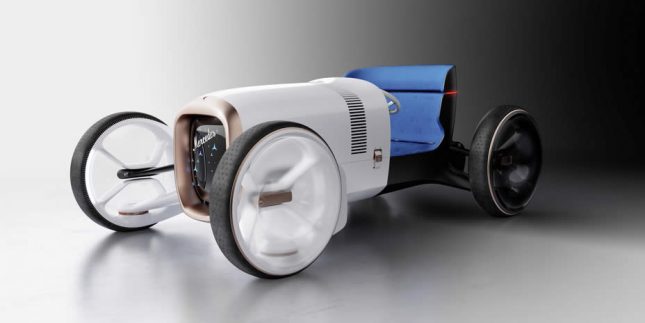
Could you imagine what a car designed 120 years ago would look like if it had been redesigned today? Built as a tribute to the first car ever designed by Mercedes called the 1901 Mercedes Simplex, this car has a front engine and an entire design inspired from the old car. No production had ever been planned for this car.
Tesla Cybertruck
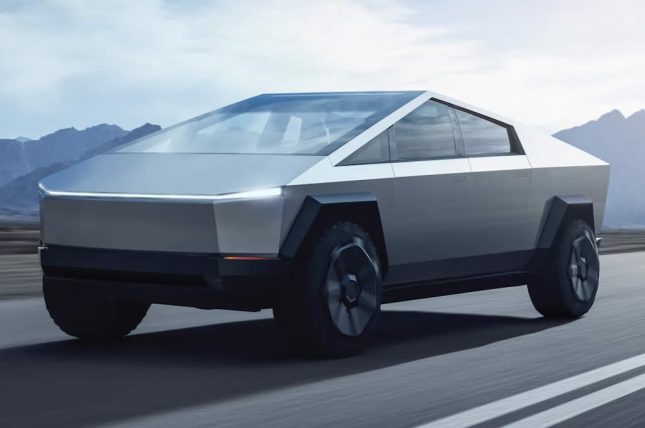
The list wouldn’t have been completed if we didn’t include Tesla Cybertruck. This futuristic car was presented for the first time in 2019 via a teaser image, but Elon Musk was actually dreaming of this car since 2012. He had the design already in his head and even the unusual, large size of this car that was inspired by the Ford F-150. The final result was a six-seater electric light-duty truck. The electric truck comes in four different models such as Single Motor RWD with a top speed of 175 km/h, Dual Motor RWD with 195 km/h, Tri-Motor AWD, and last but least the Quad Motor AWD. The silver shade of the Tesla Cybertruck is not a true color, but the stainless steel sheet metal itself, from which the car is made. The material is known for its properties such as being bullet-resistant and very durable. The car includes a self-leveling suspension, onboard power inverters, an air compressor for powering pneumatic tools, as well as a 17-inch display.
Lotus Europa
Lotus Europa was not a single car, but several types of vehicles. Between 1966 and 1975 five out of six types of vehicles were produced while the sixth type, called Type 121 Europa S, was manufactured between 2006 and 2010. Lotus wanted all Europa models to have the lowest possible production costs, so they turned to other car parts manufacturers than Ford. That’s why the Europa models were equipped with Renault parts, including the Renault 16’s engine that offered a higher compression ratio (10.25 instead of 8.6), larger inlet valves, revised valve timings, and dual valve springs.
Type 46

With only 296 units sold, the Lotus Europa Type 46 came with a Renault 16, 1,470 cc inline-four engine and with a weight of 610 kg (1,435 lb). The car also had a 4-speed gearbox, an aluminum dashboard, and could achieve a top speed of 121 mph (195 km/h).
Type 54
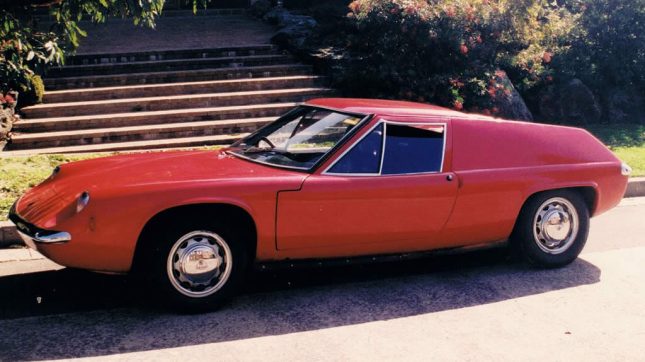
The model appeared in 1968 and came with a lot of improvements over the previous model. Even if it kept the same engine as the Type 46, the Lotus Europa Type 54 featured electric windows, adjustable seats, a carpeted interior, as well as a special dashboard decorated with a polished wooden fascia panel.
Type 74 (Twin Cam)

The next model from Lotus Europa was made available in 1971 with a new special engine named Lotus-Ford Twin Cam with 150 hp and 1,577 cc and a new four-speed gearbox made by Renault. This vehicle weighed 740 kg (1,632 lb) and was re-named later from Twin Cam to Big Valve.
Type 47 and 62
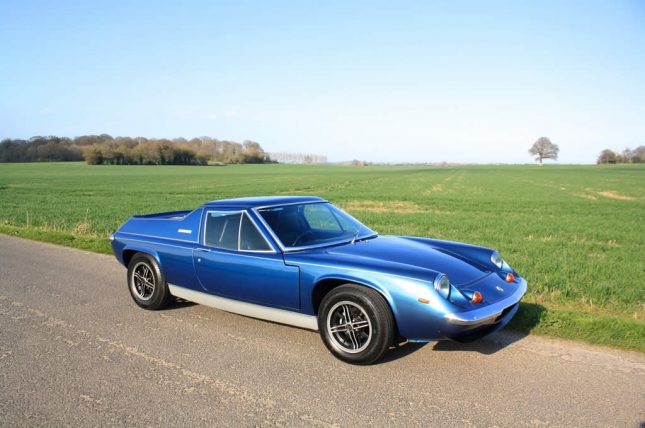
Based on the Lotus Europa’s earlier types, this vehicle was special because it was turned into a race car. What had different than the other ones were the side vents in the engine bay, the engine itself was changed with a Lotus-Ford Twin Cam with 165 hp, the gearbox, while the rear suspension was used from Lotus 23 Formula Junior car.
Dhabiyan 10×10 – The Monster SUV from Abu Dhabi

From the first moment when we see this monstrosity of an SUV called Dhabiyan 10×10, we realize that the imagination of the human being has no limits.
The Dhabiyan 10×10 was first presented at the Dubai Motor Show in 2017 and it is owned by Sheikh Hamad bin Hamdan Al Nahyan. The five-axle vehicle is based on the US Oshkosh M1075 military truck and is powered by the original 15.2-liter Caterpillar diesel engine that produces 600hp – which is needed to push forward this 10 wheels monster SUV. It is 10 meters long, 2.5 meters wide and 3 meters high. It weighs no less than 21 tons.
Now the world’s biggest SUV can be admired at The Emirates National Auto Museum.
If for us, in the 21st century, this car looks like a UFO, then I wonder how people in the 10th and 15th centuries would have reacted if they had seen such a monster.
1938 Phantom Corsair Prototype
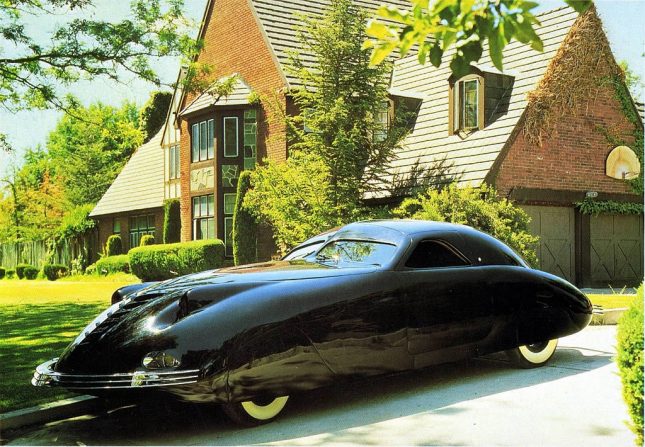
Another car that seems to be detached from an SF movie and falls without problems in our category of the strangest car is this Phantom Corsair. It is a six-passenger 2-door sedan that was designed by Rust Heinz in 1938.
Unfortunately, the Phantom Corsair is just a prototype that has never seen the mass production line. The main reason seems to be the untimely death of Rust Heinz in 1939 in a car accident. Another reason is that the Corsair was regarded as ahead of its time because of its futuristic features, and styling cues such as faired-in fenders and a low profile.
For those who want to see this car in the flesh and bone, it is in the National Automobile Museum in Reno, Nevada.


